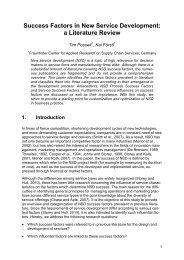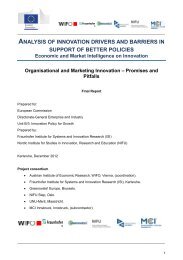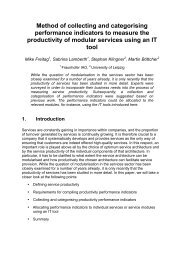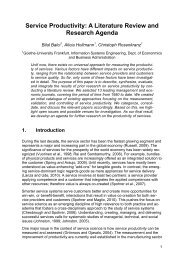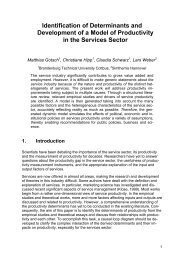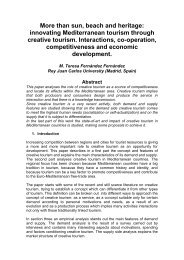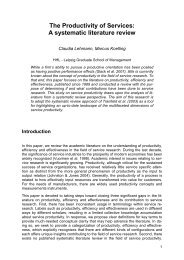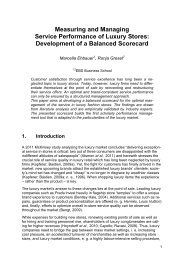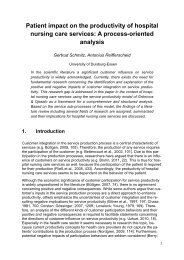Measurement of productivity of property services – an ... - RESER
Measurement of productivity of property services – an ... - RESER
Measurement of productivity of property services – an ... - RESER
Create successful ePaper yourself
Turn your PDF publications into a flip-book with our unique Google optimized e-Paper software.
XXI. International <strong>RESER</strong> Conference:<br />
<strong>Measurement</strong> <strong>of</strong> <strong>productivity</strong> <strong>of</strong> <strong>property</strong><br />
<strong>services</strong> – <strong>an</strong> empiric <strong>an</strong>alysis <strong>of</strong> the status<br />
quo<br />
Torben Bernhold, Nina Kaling, V<strong>an</strong>essa Lellek<br />
University <strong>of</strong> Applied Sciences Münster, Faculty <strong>of</strong> Ecotrophology - Facility M<strong>an</strong>agement<br />
In scientific literature, the <strong>productivity</strong> <strong>of</strong> <strong>services</strong> <strong>an</strong>d in particular its<br />
measurement represent a yet little researched area <strong>of</strong> study. Currently<br />
there exists neither a unified definition nor applicable measuring methods.<br />
These issues are also reflected in practice. The import<strong>an</strong>ce <strong>of</strong> <strong>services</strong><br />
has been discovered; however, for the exploitation <strong>of</strong> hidden potential for<br />
<strong>productivity</strong>, no generic solution has been found. This paper <strong>of</strong>fers <strong>an</strong><br />
overview <strong>of</strong> the comprehension <strong>of</strong> <strong>productivity</strong> <strong>an</strong>d methods <strong>of</strong> measurement<br />
within the field <strong>of</strong> Facility M<strong>an</strong>agement (FM).<br />
1. Introduction<br />
In the course <strong>of</strong> the last three decades, the interest in <strong>services</strong> has increased signific<strong>an</strong>tly.<br />
Enterprises are facing the challenge <strong>of</strong> adapting to the rising dem<strong>an</strong>ds on <strong>services</strong><br />
in our society, in order to remain competitive <strong>an</strong>d to be able to exist on the<br />
market. This becomes particularly apparent due to the fact that the supply <strong>of</strong> <strong>services</strong><br />
is ever increasing, whether they are autonomic <strong>services</strong> or Value Added Services<br />
(Kirchgeorg, 2009, 3147). Increasing growth <strong>of</strong> the supply <strong>of</strong> <strong>services</strong> is accomp<strong>an</strong>ied<br />
by the service comp<strong>an</strong>ies' intensification <strong>of</strong> competition <strong>an</strong>d its connected pursuit for<br />
pr<strong>of</strong>itability, which is characterized by a contested quest for quality, price/costs <strong>an</strong>d<br />
time (Lassh<strong>of</strong>, 2006, 1; Bruhn; Meffert, 2001, 3). In entrepreneurial objectives,<br />
<strong>productivity</strong> increasing intentions have, therefore, foregrounded themselves, for inst<strong>an</strong>ce<br />
<strong>of</strong>fered <strong>services</strong> with minimal resource expenditure to be produced or such<br />
<strong>services</strong> to be utilized in such a m<strong>an</strong>ner that maximal perform<strong>an</strong>ce results c<strong>an</strong> be<br />
achieved (Kern, 1992, 65; Lassh<strong>of</strong>, 2006, 1). Through these me<strong>an</strong>s, the strive for<br />
optimized production processes wins, which is in pursuit <strong>of</strong> <strong>an</strong> increase in service<br />
provision efficiency in terms <strong>of</strong> pr<strong>of</strong>itability <strong>an</strong>d <strong>productivity</strong>, since unproductive actions<br />
c<strong>an</strong> lead to a suboptimal resource allocation <strong>an</strong>d to disadv<strong>an</strong>tages in competition<br />
(Lassh<strong>of</strong>, 2006, 1). Ins<strong>of</strong>ar as improvement <strong>of</strong> <strong>productivity</strong>, output <strong>an</strong>d input must<br />
be taken into consideration; the const<strong>an</strong>t improvement <strong>of</strong> <strong>productivity</strong> is therefore a<br />
subst<strong>an</strong>tial perform<strong>an</strong>ce parameter in the attainment <strong>of</strong> long-term service provider<br />
adv<strong>an</strong>tages for enterprises (Grönroos; Ojasalo, 2004, 414; Lassh<strong>of</strong>, 2006, 1).<br />
The measurement <strong>an</strong>d control <strong>of</strong> service perform<strong>an</strong>ce <strong>productivity</strong> presents practical<br />
applications, such as also the scientific <strong>an</strong>alysis <strong>of</strong> gained <strong>productivity</strong>, with various<br />
challenges. While the classic <strong>productivity</strong> concept <strong>of</strong> material goods production<br />
makes itself out to be relatively uncomplicated, the measurement <strong>of</strong> service perform<strong>an</strong>ce<br />
<strong>productivity</strong> according to scientific examinations requires the integration <strong>of</strong><br />
1
further parameters for the ascertainment <strong>of</strong> resource employment <strong>an</strong>d <strong>of</strong> targeted<br />
perform<strong>an</strong>ce results. According to that, various scientific approaches, which consider<br />
<strong>productivity</strong> factors in various m<strong>an</strong>ners <strong>an</strong>d are integrated in measurement, exist for<br />
the measurement <strong>of</strong> <strong>productivity</strong> in <strong>services</strong> (Lassh<strong>of</strong>, 2006, 108; Grönroos; Ojasalo,<br />
2004, 416; Johnston; Jones, 2004, 203; Corsten, 1994, 60; Gummesson, 1998, 4).<br />
Consequently, at this time neither a generally binding underst<strong>an</strong>ding <strong>of</strong> service perform<strong>an</strong>ce<br />
<strong>productivity</strong> nor a widely accepted term <strong>of</strong> <strong>productivity</strong>, with which service<br />
perform<strong>an</strong>ce <strong>productivity</strong> c<strong>an</strong> be calculated exactly, exist (Baumgärtner; Bienzeisler,<br />
2006, 8).<br />
The difficulties in the tr<strong>an</strong>sfer <strong>of</strong> classic <strong>productivity</strong> terms to service perform<strong>an</strong>ces<br />
are caused by the various properties <strong>of</strong> material goods <strong>an</strong>d service perform<strong>an</strong>ces<br />
(Baumgärtner; Bienzeisler, 2006, 21; Lassh<strong>of</strong>, 2006, 2; Grönroos; Ojasalo, 2004,<br />
416; Johnston; Jones, 2004, 203). The distinction <strong>of</strong> service perform<strong>an</strong>ces presents a<br />
further challenge for the development <strong>of</strong> <strong>productivity</strong> terms as well as the establishing<br />
conception <strong>of</strong> a measurement model (Bernhold, 2010, 32; Lassh<strong>of</strong>, 2006, 47; Corsten;<br />
Gössinger, 2007, 27). The m<strong>an</strong>ifestation <strong>of</strong> <strong>services</strong> perform<strong>an</strong>ces exhibits a<br />
high heterogeneity, so identification <strong>of</strong> signific<strong>an</strong>t <strong>productivity</strong> factors <strong>an</strong>d their m<strong>an</strong>ifestation<br />
become complicated (Lassh<strong>of</strong>, 2006, 63; Ojasalo, 1999, 60; Baumgärtner;<br />
Bienzeisler, 2006, 32).<br />
Against the background <strong>of</strong> the problems in distinction <strong>an</strong>d the heterogeneity <strong>of</strong> service<br />
perform<strong>an</strong>ces, the presented research concentrates on <strong>property</strong>-orientated service<br />
perform<strong>an</strong>ces <strong>an</strong>d examines these as a particular service perform<strong>an</strong>ce type for<br />
possible approaches for the measurement <strong>of</strong> <strong>productivity</strong>.<br />
In the following, practical work will, therefore, be depicted through carried out interviews<br />
with experts. The presented paper reflects the views <strong>of</strong> the experts from practice<br />
<strong>an</strong>d c<strong>an</strong> be used as foundation for a model for measurement <strong>of</strong> <strong>productivity</strong> to<br />
complement existing approaches found in literature.<br />
2. Empirical study <strong>of</strong> <strong>productivity</strong> measurements <strong>of</strong><br />
<strong>property</strong>-orientated service perform<strong>an</strong>ces<br />
2.1. Research-leading study questions<br />
The study <strong>of</strong> evaluative parameters <strong>an</strong>d specific factors <strong>of</strong> <strong>productivity</strong> measurement<br />
<strong>of</strong> <strong>property</strong>-orientated service perform<strong>an</strong>ces is based upon the following researchleading<br />
questions:<br />
“Which measuring methods for the <strong>productivity</strong> <strong>of</strong> <strong>property</strong>-orientated service perform<strong>an</strong>ces<br />
during the operating stage have established themselves in practice, <strong>an</strong>d<br />
which parameters <strong>an</strong>d specific factors form the basis <strong>of</strong> these?”<br />
Up to now, predomin<strong>an</strong>tly theory-driven approaches, which most <strong>of</strong> these were not<br />
determined in practice, exist for <strong>productivity</strong> measurement <strong>of</strong> service perform<strong>an</strong>ces.<br />
The presented research should contribute to the ascertainment <strong>of</strong> practical perspectives<br />
<strong>of</strong> service-specified <strong>productivity</strong> terms <strong>an</strong>d should also contribute to the evaluation<br />
<strong>of</strong> how theory-driven <strong>productivity</strong> factors are utilized.<br />
2
The presented research draws ins<strong>of</strong>ar primarily on the description <strong>of</strong> the underst<strong>an</strong>ding<br />
<strong>of</strong> <strong>productivity</strong> currently dominating the <strong>property</strong> market <strong>an</strong>d also <strong>of</strong> the basic<br />
me<strong>an</strong>ing <strong>of</strong> appropriate measurements within this type <strong>of</strong> <strong>services</strong>. The identification<br />
<strong>of</strong> existing evaluative parameters for measuring <strong>productivity</strong> in <strong>property</strong>-orientated<br />
service perform<strong>an</strong>ces during the operation <strong>of</strong> properties <strong>an</strong>d also the appraisal <strong>of</strong><br />
perform<strong>an</strong>ce individualized <strong>productivity</strong> factors are components <strong>of</strong> this research. This<br />
study also integrates within its process aspects <strong>an</strong>d questions related to integrating<br />
factors for the measurement <strong>of</strong> <strong>productivity</strong>, on the one h<strong>an</strong>d, <strong>an</strong>d on the other h<strong>an</strong>d,<br />
measurement <strong>of</strong> evaluating service-perform<strong>an</strong>ce dimensions in general.<br />
The primary questions <strong>an</strong>d existing theory-based reflections <strong>of</strong> <strong>productivity</strong> in service<br />
perform<strong>an</strong>ces create four areas <strong>of</strong> study. These specify the central issues <strong>of</strong> the present<br />
empiricism in terms <strong>of</strong> content <strong>an</strong>d constitute the central questions <strong>of</strong> the present<br />
research study:<br />
Area <strong>of</strong> study Content-related question<br />
Underst<strong>an</strong>ding<br />
<strong>of</strong> <strong>productivity</strong><br />
<strong>Measurement</strong> <strong>of</strong><br />
<strong>productivity</strong><br />
Which underst<strong>an</strong>dings <strong>of</strong> <strong>productivity</strong> c<strong>an</strong> be stated for the field <strong>of</strong> Facility M<strong>an</strong>agement?<br />
Which methods are already being used to measure the <strong>productivity</strong> <strong>of</strong> <strong>property</strong>-orientated<br />
service perform<strong>an</strong>ces?<br />
Measuring pa- Which measuring parameters call for the measurement <strong>of</strong> <strong>productivity</strong>?<br />
rameters<br />
S<strong>of</strong>tware use Which s<strong>of</strong>tware support c<strong>an</strong> determine the measurement <strong>of</strong> <strong>productivity</strong> <strong>of</strong> <strong>property</strong>orientated<br />
service perform<strong>an</strong>ces?<br />
Table 1: Areas <strong>of</strong> study in the research project<br />
2.2. Study design<br />
The study-driving questions were constituted under the aim to inquire about the existing<br />
underst<strong>an</strong>ding <strong>of</strong> <strong>productivity</strong> <strong>an</strong>d the existing methods <strong>of</strong> measurement including<br />
evaluative parameters <strong>an</strong>d information technology systems in the field <strong>of</strong> facility<br />
m<strong>an</strong>agement (FM) <strong>an</strong>d by which to depict the practical reality <strong>of</strong> <strong>property</strong>-orientated<br />
<strong>services</strong> during the operational phase <strong>of</strong> properties. As a empirical-<strong>an</strong>alytical study<br />
(Laatz, 1993, 9), it focuses on the presentation <strong>of</strong> presently applied measuring systems<br />
for <strong>productivity</strong>, <strong>an</strong>d it is, secondly, seen as a process in <strong>an</strong> exploratory research<br />
approach, which finds use in particular during new <strong>an</strong>d partially unresearched<br />
research issues (Diekm<strong>an</strong>n, 2002, 30; Gläare; Laudel, 2006, 84). Especially against<br />
the background <strong>of</strong> the complexity <strong>of</strong> facility m<strong>an</strong>agement, the diversity <strong>of</strong> facility service<br />
perform<strong>an</strong>ces <strong>an</strong>d as well as the basis <strong>of</strong> disciplinary innovations in FM, this research<br />
study is to be carried out in the form <strong>of</strong> a qualitative study as exploration <strong>of</strong><br />
study objects (Kromrey, 2006, 72).<br />
3
Literary examination <strong>of</strong><br />
the research question<br />
Operationalisation<br />
Overpass into a questionnaire<br />
Ad Hoc Integration<br />
Survey data<br />
Problem-centered interview<br />
<strong>of</strong> experts<br />
Findings from the discourse<br />
Data processing<br />
Verbatim tr<strong>an</strong>scription<br />
Data <strong>an</strong>alysis<br />
Qualitative content <strong>an</strong>alysis<br />
Presentation <strong>of</strong> results<br />
Answering the research question<br />
from a practical perspective<br />
process running<br />
Research question<br />
Concretization <strong>of</strong> the<br />
research question<br />
knowledge flow<br />
Fig. 1: Research process <strong>an</strong>d methodology <strong>of</strong> study<br />
In total, this empiric study comprises <strong>of</strong> 12 expert interviews, which c<strong>an</strong> be segmented<br />
into the areas: service provider, user <strong>an</strong>d academics. Service providers are experts<br />
from comp<strong>an</strong>ies, whose core business is the provision <strong>of</strong> facility-m<strong>an</strong>agement<br />
<strong>services</strong>. In contrast, users are customers <strong>of</strong> facility service perform<strong>an</strong>ces. Academics<br />
is represented by a further area <strong>of</strong> teaching in FM. The integration <strong>of</strong> academics<br />
<strong>of</strong>fers the possibility to <strong>an</strong>swer research-driven questions from a theoretical perspective<br />
<strong>of</strong> facility-m<strong>an</strong>agement disciplines <strong>an</strong>d thereby to raise the validity <strong>of</strong> study results<br />
from a theory-driven perspective.<br />
4
Field <strong>of</strong> activity Number <strong>of</strong><br />
employees<br />
Annual turnover<br />
(in mi. €)<br />
Number <strong>of</strong> interviewed<br />
persons<br />
1 Service provider FM 10.776 1.444,0 2<br />
2 Service provider FM 10.300 730,0 2<br />
3 Service provider FM 2.700 1.200,0 1<br />
4 Service provider<br />
REM/ FM<br />
7.300 950,0 1<br />
5 Service provider FM 9.139 387,9 1<br />
6 Service provider FM 24.158 362,0 2<br />
7 Service provider FM 1.400 55,9 1<br />
8 Service provider IT-Services 300 40,0 1<br />
9 User FM 1.500 2.234,0 2<br />
10 User AM/ FM 2.000 1.334,4 1<br />
11 User AM/ FM 60 27,0 1<br />
12 Academics FM - - 1<br />
Table 2: Interview partners in expert interviews<br />
The raised interview material was given in a complete text form in normal written<br />
Germ<strong>an</strong> <strong>an</strong>d was cleared <strong>of</strong> <strong>an</strong>y syntax mistakes as well. Subsequently, a communicative<br />
validation <strong>an</strong>d feedback <strong>of</strong> raised data material was carried out with interview<br />
particip<strong>an</strong>ts (Gläser; Laudel, 2006, 188; Bortz; Döring, 2006, 311; Flick, 1987, 254).<br />
The document released by the experts formed the basis <strong>of</strong> a detailed interpretative<br />
evaluation <strong>of</strong> data material (Mayring, 2002, 91; Mayer, 2009, 47).<br />
2.3. Qualitative content <strong>an</strong>alysis <strong>of</strong> data material<br />
The selected evaluation process <strong>of</strong> raised interview materials is a qualitative content<br />
<strong>an</strong>alysis according to MAYRING. The research material <strong>of</strong> the present research consists<br />
<strong>of</strong> the complete tr<strong>an</strong>scripts from the carried out expert interviews. Each interview<br />
was taken into <strong>an</strong>alysis, as due to the exploratory nature <strong>of</strong> this research no selective<br />
criteria could be defined without being able to exclude <strong>an</strong>y distortion to reality<br />
perception. The interview partners for the expert interviews were selected from the<br />
research population according research-related features. These partners also represent<br />
the results <strong>of</strong> a r<strong>an</strong>dom selection.<br />
Following the determination <strong>of</strong> research materials, the <strong>an</strong>alysis orientation took place,<br />
which specified particular <strong>an</strong>alysing techniques <strong>an</strong>d the model procedure for <strong>an</strong>alysis<br />
(Mayring, 2003, 52). Research object <strong>of</strong> the content <strong>an</strong>alysis are the specifics <strong>of</strong><br />
<strong>productivity</strong> measurement from a practical perspective. Research material is to be<br />
examined ins<strong>of</strong>ar for statements about the object <strong>of</strong> research, while excluding personal,<br />
biographical or sociocultural backgrounds from <strong>an</strong>alytical research.<br />
For the evaluation <strong>of</strong> the present inquiries, a structured content <strong>an</strong>alysis was selected.<br />
Goal <strong>of</strong> the research was ins<strong>of</strong>ar to inquire about specific features <strong>of</strong> practical<br />
5
measurement models <strong>of</strong> <strong>productivity</strong> <strong>an</strong>d about underlying practical underst<strong>an</strong>dings<br />
<strong>of</strong> <strong>productivity</strong> factors.<br />
The <strong>an</strong>alytical category system, which this research underlies, was derived from the<br />
dimensional differentiation <strong>of</strong> research-driven questions. This system serves also as<br />
a basis for the development <strong>of</strong> a guideline for the interviews. As the basis <strong>of</strong> ascertaining<br />
variables <strong>of</strong> individual subject areas, categories <strong>an</strong>d subcategories were developed<br />
successively in four material processes, which contain the reference terms<br />
<strong>of</strong> text passages. The multiple adaptation <strong>of</strong> the category system was dissected into<br />
individual categories due to the qu<strong>an</strong>tity <strong>of</strong> present text references, <strong>an</strong>d this required<br />
a theory-driven differentiation <strong>of</strong> isolated dimensions, which c<strong>an</strong> also modify encoding<br />
rules <strong>an</strong>d st<strong>an</strong>dard examples.<br />
The final category system includes six main categories, which include in total 34 subcategories.<br />
Fig. 2: Categories <strong>of</strong> the qualitative <strong>an</strong>alysis<br />
The subject area <strong>productivity</strong> measurement comprises the categories process st<strong>an</strong>dards<br />
as well as starting points <strong>an</strong>d modularization <strong>of</strong> measurement, because the research-leading<br />
questions focuses primarily on the <strong>productivity</strong> measurement <strong>an</strong>d because<br />
the problem-oriented interviews were developed appropriately for the<br />
examination <strong>of</strong> measuring methods.<br />
The qualitative <strong>an</strong>alysis was completely checked by one <strong>of</strong> the two authors <strong>an</strong>d were<br />
subsequently adjusted <strong>an</strong>d verified with regard towards results or references <strong>an</strong>d<br />
classification within the category system.<br />
The following presentation <strong>of</strong> results was carried out fittingly for the structured content<br />
<strong>an</strong>alysis according to MAYRING <strong>an</strong>d with the help <strong>of</strong> the developed category<br />
system initially on the basis <strong>of</strong> subcategories, which were summarized into the six<br />
main categories (Mayring, 2003, 89). The implicit interpretation <strong>of</strong> found data resulted<br />
against the background <strong>of</strong> scientific findings.<br />
6
2.4. Presentation <strong>of</strong> results against the background <strong>of</strong> research<br />
leading questions<br />
The following presentations expatiate the content-<strong>an</strong>alytically established results <strong>an</strong>d<br />
core statements parallel to the category system upon aggregated levels. For better<br />
assessment <strong>an</strong>d evaluation <strong>of</strong> occasionally differentiated statements <strong>an</strong>d results, the<br />
core statements have been presented according to their homogeneity. (high = clear<br />
<strong>an</strong>d predomin<strong>an</strong>t homogeneity in expert statements, medium = differentiated expert<br />
statements <strong>an</strong>d assessments, low = signific<strong>an</strong>tly diverging expert statements <strong>an</strong>d<br />
assessments). These additional assessments allow furthermore for good structure<br />
<strong>an</strong>d evaluation <strong>of</strong> currently still vac<strong>an</strong>t aspects <strong>an</strong>d questions with regard towards<br />
practice as well as academics.<br />
2.4.1. Category 1: Underst<strong>an</strong>dig <strong>of</strong> <strong>productivity</strong><br />
Within the subject area <strong>of</strong> underst<strong>an</strong>ding <strong>of</strong> <strong>productivity</strong>, various parameters were<br />
examined, which represent the basic features <strong>of</strong> existing considerations <strong>of</strong> <strong>productivity</strong><br />
in <strong>property</strong>-orientated practice.<br />
Subcategory<br />
Perception <strong>of</strong><br />
<strong>productivity</strong><br />
Me<strong>an</strong>ing <strong>of</strong><br />
<strong>productivity</strong><br />
Effects <strong>of</strong><br />
<strong>productivity</strong><br />
Goals <strong>of</strong><br />
<strong>productivity</strong><br />
Possibilities for<br />
adaptation in<br />
methods <strong>of</strong><br />
measuring material<br />
goods<br />
Factors <strong>of</strong><br />
<strong>productivity</strong><br />
Essential core statements in the context <strong>of</strong> the content<strong>an</strong>alysis<br />
evaluation<br />
Closely related dependence on the underst<strong>an</strong>ding <strong>of</strong> <strong>productivity</strong><br />
in material goods; conceived input-output relation essentially<br />
based upon internal as well as external input factors <strong>an</strong>d output<br />
sizes, which comprise <strong>of</strong> quality <strong>an</strong>d qu<strong>an</strong>tity <strong>of</strong> one service<br />
Me<strong>an</strong>ing <strong>of</strong> <strong>productivity</strong> measurement within the process <strong>of</strong> producing<br />
a service essentially recognizable; me<strong>an</strong>ing <strong>of</strong> <strong>productivity</strong><br />
measurement – as <strong>an</strong> <strong>an</strong>alogue to material goods – suitably high<br />
Better controllability <strong>of</strong> service products by the me<strong>an</strong>s <strong>of</strong> detailed<br />
calculations <strong>an</strong>d identification <strong>of</strong> optimizing potentials; target <strong>an</strong>d<br />
real value comparison <strong>of</strong> service processes increase tr<strong>an</strong>sparency<br />
<strong>an</strong>d generation <strong>of</strong> information; economical completion <strong>of</strong> tasks,<br />
pr<strong>of</strong>it maximization; quality improvements with positive effects on<br />
customer satisfaction<br />
Increase in efficiency <strong>of</strong> service provision as well as time savings<br />
on the basis <strong>of</strong> cost <strong>an</strong>d process optimizing service provisions,<br />
which imply <strong>an</strong> optimized application <strong>of</strong> resources<br />
Essential possibility <strong>of</strong> tr<strong>an</strong>sfer with regard towards characteristic<br />
service features possible<br />
Differentiation in input <strong>an</strong>d output sizes; input factors comprise <strong>of</strong><br />
costs <strong>an</strong>d time as well as further external factors, for example the<br />
location <strong>of</strong> service, also employee qualifications <strong>an</strong>d satisfaction<br />
c<strong>an</strong> be taken into consideration; output factors c<strong>an</strong> be divided<br />
mainly into service qu<strong>an</strong>tity <strong>an</strong>d quality, whereupon customer<br />
satisfaction c<strong>an</strong> be implied<br />
Table 3: Underst<strong>an</strong>ding <strong>of</strong> <strong>productivity</strong> in practice within FM fields<br />
Homogeneity<br />
<strong>of</strong> statements<br />
low<br />
high<br />
high<br />
high<br />
medium<br />
medium<br />
7
The expert statements reflect thereby the current theory-dominated heterogeneous<br />
underst<strong>an</strong>ding with regard towards the measurement <strong>of</strong> service <strong>productivity</strong>. While a<br />
basic consensus c<strong>an</strong> be implied in me<strong>an</strong>ing, effects <strong>an</strong>d goals with regard towards<br />
measurement, occasionally differentiated perceptions c<strong>an</strong> be found especially within<br />
terms <strong>of</strong> concepts <strong>an</strong>d within terms <strong>of</strong> tr<strong>an</strong>sfer from the area <strong>of</strong> material goods as well<br />
as the tr<strong>an</strong>sfer <strong>of</strong> factors needed for integration.<br />
2.4.2. Category 2: Productivity measurement<br />
Against the background <strong>of</strong> the research question guiding, this research focuses on<br />
the topic <strong>of</strong> <strong>productivity</strong> measurement <strong>an</strong>d thus presents the core <strong>of</strong> the collected results.<br />
Table 4 lists the results within the given categories in the focus <strong>of</strong> <strong>productivity</strong><br />
measurement as well as the structuring <strong>of</strong> data evaluation with associated subcategories.<br />
Subcategory<br />
<strong>Measurement</strong><br />
methods<br />
Possible<br />
measurement<br />
methods<br />
Difficulties <strong>of</strong><br />
measurement<br />
Specifics <strong>of</strong><br />
measurement<br />
for FM-<strong>services</strong><br />
Prerequisites <strong>of</strong><br />
<strong>productivity</strong><br />
measurement<br />
Essential core statements in the context <strong>of</strong> the content<strong>an</strong>alysis<br />
evaluation<br />
Integration <strong>of</strong> monetary ratios; prevailing consideration <strong>of</strong> costs at<br />
different levels - from a generic <strong>productivity</strong>-<strong>an</strong>alysis at the level <strong>of</strong><br />
return on sales, to contract- <strong>an</strong>d perform<strong>an</strong>ce-individual measurements;<br />
no currently existing measurement integrates all relev<strong>an</strong>t<br />
factors in <strong>productivity</strong> measurement; measurements <strong>of</strong> output-quality<br />
<strong>an</strong>d customer satisfaction are separated mainly by the<br />
<strong>productivity</strong> measurement using monetary values<br />
Currently there are no uniform measurement methods available;<br />
Few examples <strong>of</strong> possible methods: extension <strong>of</strong> the input dimensions<br />
for the hum<strong>an</strong> factor <strong>of</strong> a perform<strong>an</strong>ce, as me<strong>an</strong> value <strong>of</strong><br />
qualifying service staff; target costing with integrated activitybased<br />
costing (systematic <strong>an</strong>d consistent ascertainment <strong>of</strong><br />
<strong>productivity</strong>, digital mapping <strong>of</strong> measuring points, measurements<br />
qu<strong>an</strong>tities within the process is import<strong>an</strong>t as well as benchmarking)<br />
Complexity <strong>an</strong>d int<strong>an</strong>gibility <strong>of</strong> certain perform<strong>an</strong>ce processes<br />
complicate the creation <strong>of</strong> specific perform<strong>an</strong>ce targets <strong>an</strong>d the<br />
creation <strong>of</strong> a comparable basis as well as evaluation <strong>of</strong> the perform<strong>an</strong>ce<br />
results; furthermore the measurement is complicated by<br />
the influence <strong>of</strong> unpredictable factors; customer satisfaction is <strong>an</strong><br />
uncertain qu<strong>an</strong>tity that is not clearly defined; due to the subjectivity<br />
<strong>of</strong> the quality assessment the <strong>an</strong>alysis <strong>of</strong> quality constitutes to<br />
be difficult<br />
Productivity measurements <strong>of</strong> FM-<strong>services</strong> are basically identically,<br />
as the basis for measuring is always the time <strong>of</strong> discharge by<br />
perform<strong>an</strong>ce; in comparison to infrastructural <strong>an</strong>d technical <strong>services</strong>,<br />
the measurement <strong>of</strong> commercial <strong>services</strong> due to the complexity<br />
<strong>of</strong> its processes is assessed as more difficult<br />
The processual view <strong>of</strong> the perform<strong>an</strong>ce for the identification <strong>of</strong><br />
measurement points; clear definiton <strong>of</strong> the target state <strong>of</strong> perform<strong>an</strong>ce<br />
in quality <strong>an</strong>d qu<strong>an</strong>tity, defining key perform<strong>an</strong>ce indicators<br />
<strong>an</strong>d objective indicators for quality assessment<br />
Table 4: <strong>Measurement</strong> <strong>of</strong> <strong>productivity</strong> in practice<br />
Homogeneity<br />
<strong>of</strong> statements<br />
low<br />
low<br />
high<br />
medium<br />
high<br />
8
The propositions from the experts in this category emphasize achieved results <strong>an</strong>d<br />
conclusions. Regarding existing <strong>an</strong>d potential measurement methods, a wide r<strong>an</strong>ge<br />
<strong>of</strong> possible measurement methods in the field <strong>of</strong> FM c<strong>an</strong> be detected, which is primarily<br />
due to the diversity <strong>of</strong> the definition <strong>an</strong>d assessments methods while appraising<br />
elements that rely on the factors <strong>an</strong>d indicators. Nevertheless, the experts note<br />
that a generic method could be used to measure the <strong>productivity</strong> <strong>of</strong> FM <strong>services</strong>, but,<br />
for this method, unique st<strong>an</strong>dards <strong>an</strong>d indicators need to be developed along a system<br />
<strong>of</strong> evaluation-surrogates.<br />
2.4.3. Category 3: Process st<strong>an</strong>dards<br />
The ascertainment <strong>an</strong>d description <strong>of</strong> process st<strong>an</strong>dards for the provision <strong>of</strong> FM <strong>services</strong><br />
was used in particular to <strong>an</strong>swer the question <strong>of</strong> whether <strong>an</strong>d to what extent<br />
process st<strong>an</strong>dards c<strong>an</strong> be used as the basis <strong>of</strong> the measurement processes <strong>of</strong> service<br />
<strong>productivity</strong> in FM fields. Table 5 summarizes the relev<strong>an</strong>t statements on <strong>an</strong> abstracting<br />
level:<br />
Subcategory<br />
Import<strong>an</strong>ce <strong>of</strong><br />
process<br />
st<strong>an</strong>dards<br />
Definition <strong>of</strong><br />
process<br />
st<strong>an</strong>dards<br />
Factors <strong>of</strong> the<br />
process<br />
individuality<br />
Status quo <strong>of</strong><br />
process<br />
st<strong>an</strong>dards<br />
Process level<br />
Process visualization<br />
<strong>an</strong>d<br />
communication<br />
Essential core statements in the context <strong>of</strong> the content<strong>an</strong>alysis<br />
evaluation<br />
The use <strong>of</strong> process st<strong>an</strong>dards is rated <strong>of</strong> the respondents as<br />
appropriate <strong>an</strong>d necessary foundation for <strong>productivity</strong><br />
measurement to uncover optimization opportunities to enh<strong>an</strong>ce<br />
service quality <strong>an</strong>d contribute to achieving the desired state<br />
In the FM-practice process st<strong>an</strong>dards are recognized as <strong>an</strong><br />
execution <strong>of</strong> summarized <strong>an</strong>d similar processes, which still allow<br />
certain modifications without departing from the prescribed<br />
st<strong>an</strong>dard. Basically, according to the respondents the possibility <strong>of</strong><br />
using st<strong>an</strong>dardization process in all FM areasist given, though the<br />
ascertainment <strong>an</strong>d implementation is rated more difficult in the<br />
commercial sector th<strong>an</strong> in technical or infrastructual<br />
Basically, there are according to the experts in each st<strong>an</strong>dard<br />
product-process individual issues available. This does not affect<br />
the <strong>productivity</strong> measurement, as individual perform<strong>an</strong>ce c<strong>an</strong> be<br />
measured with higher-level metrics. But it is still import<strong>an</strong>t to decide<br />
the level <strong>of</strong> the process visualization <strong>an</strong>d abstraction<br />
Homogeneity<br />
<strong>of</strong> statements<br />
Very heterogeneous in terms <strong>of</strong> the degree <strong>of</strong> st<strong>an</strong>dardization low<br />
In approximately 50% <strong>of</strong> surveyed comp<strong>an</strong>ies meta-processes on<br />
a generic level have been developed that describe how to perform<br />
the different <strong>services</strong> are possible <strong>an</strong>d operate customizable adaptations<br />
to the environment perform<strong>an</strong>ce<br />
There are different process descriptions, partly fine-grained based<br />
on process definitions <strong>an</strong>d process environments (e.g. on the<br />
basis <strong>of</strong> event-driven process chains), partly because <strong>of</strong> related<br />
effort based on rosters <strong>an</strong>d service pl<strong>an</strong>s; The communication <strong>of</strong><br />
process specifications is mainly on staff training, used checklists<br />
or IT-portals that are unlocked for different employee requests<br />
Table 5: Process st<strong>an</strong>dards in practice within FM fields<br />
high<br />
high<br />
high<br />
medium<br />
low<br />
9
Also in the category <strong>of</strong> process st<strong>an</strong>dards to yield comparable results. In this context,<br />
the visualization <strong>an</strong>d recording <strong>of</strong> processes or as a base to support the <strong>productivity</strong><br />
measurement <strong>of</strong> real estate <strong>services</strong> is <strong>of</strong> great import<strong>an</strong>ce is attached, on the other<br />
h<strong>an</strong>d, appropriate st<strong>an</strong>dards <strong>an</strong>d shots are up to date is not continuous. Here, in the<br />
opinion <strong>of</strong> experts to develop a generic process in the FM l<strong>an</strong>dscape seems possible,<br />
which c<strong>an</strong> be customized <strong>an</strong>d adapted to individual comp<strong>an</strong>y needs (different process<br />
level in terms <strong>of</strong> st<strong>an</strong>dardization). Subsumablely it seems, according to the experts,<br />
a the development <strong>of</strong> a generic process st<strong>an</strong>dards for the provision <strong>of</strong> FM <strong>services</strong><br />
is required <strong>an</strong>d at this particular point <strong>of</strong> view <strong>of</strong> the comparability between<br />
different comp<strong>an</strong>ies.<br />
2.4.4. Category 4: Starting points <strong>an</strong>d modularization <strong>of</strong> measurement<br />
Subcategory<br />
Input/ output<br />
measurement<br />
Internal /<br />
external<br />
measurement <strong>of</strong><br />
<strong>productivity</strong><br />
Partial<br />
productivities<br />
Integration <strong>of</strong><br />
external factors<br />
Quality<br />
Service-based<br />
quality<br />
Employee competence<br />
Essential core statements in the context <strong>of</strong> the content<strong>an</strong>alysis<br />
evaluation<br />
The input c<strong>an</strong> be differentiated into two dimensions, in the strict<br />
sense are the staff <strong>an</strong>d the work material taken, in the broad<br />
sense the investment <strong>an</strong>d fixed assets, external <strong>services</strong> <strong>an</strong>d<br />
creation requirements are included as a percentage. The output<br />
demonstrates the perform<strong>an</strong>ce results, which is divided into<br />
qu<strong>an</strong>titative <strong>an</strong>d qualitative dimension<br />
The external measurement <strong>of</strong> <strong>productivity</strong> in practice not feasible,<br />
due to not given customer willingness to become directly involved<br />
in the measurement. So far, only internal measurements are<br />
distributed<br />
On the one h<strong>an</strong>d partial <strong>productivity</strong> measurement is considered<br />
to be useful because the measurement <strong>of</strong> <strong>an</strong> entire process is too<br />
complex. On the other h<strong>an</strong>d, this measurement method is<br />
regarded as insubst<strong>an</strong>tial, because the <strong>productivity</strong> <strong>of</strong> the entire<br />
perform<strong>an</strong>ce matters purely<br />
The integration <strong>of</strong> the external factor in the <strong>productivity</strong> measurement<br />
is useful if effects are predictable. The correspondents see<br />
customer it selves as external factor <strong>of</strong> service delivery <strong>an</strong>d no<br />
object or the perform<strong>an</strong>ce environment<br />
Quality measurements are usually no absolute measurements,<br />
but a proportionate number which reflects, in how far the existing<br />
quality equals the specified quality. So a precise definition <strong>of</strong> the<br />
perform<strong>an</strong>ce <strong>an</strong>d the perform<strong>an</strong>ce goal is prerequisite for <strong>an</strong> objective<br />
quality measurement<br />
The control <strong>of</strong> perform<strong>an</strong>ce-based quality is evaluated different in<br />
the various FM <strong>services</strong>. The qualitative assessments <strong>of</strong> infrastructural<br />
<strong>services</strong> are mainly based on subjective criteria, based<br />
on the agreed Service Level Agreements. Technical support <strong>services</strong><br />
are usually monitored by the ability to function, availability<br />
<strong>an</strong>d the regulatory compli<strong>an</strong>ce through r<strong>an</strong>dom sampling. The<br />
quality audit in the commercial field usually is based on the foureye<br />
principle<br />
The quality <strong>of</strong> perform<strong>an</strong>ce depends on the qualification <strong>of</strong> the<br />
service-providing employees. Therefore a prior commencement <strong>of</strong><br />
the established qualifications <strong>of</strong> the staff is necessary. In practice,<br />
Homogeneity<br />
<strong>of</strong> statements<br />
high<br />
high<br />
medium<br />
high<br />
high<br />
medium<br />
high<br />
10
Customersatisfaction<br />
there is no established method for evaluating employee skills, so<br />
that service providers <strong>of</strong>ten rely on customer statements. However,<br />
in most <strong>of</strong> the comp<strong>an</strong>ies surveyed there is no requirement or<br />
prohibition <strong>of</strong> a <strong>productivity</strong> measurement at the employee level<br />
On the one h<strong>an</strong>d, the customer satisfaction is seen as <strong>an</strong> indicator<br />
for the service provided quality, on the other h<strong>an</strong>d, it is understood<br />
only as a general tool, customer satisfaction also integrates not<br />
only the service provider directly <strong>an</strong>d is also influenced by other<br />
active factors. Mostly the survey <strong>of</strong> customer satisfaction is separated<br />
from the measurement <strong>of</strong> <strong>productivity</strong><br />
Table 6: Starting points <strong>an</strong>d modularization <strong>of</strong> measurement in practice within FM fields<br />
The results in this category emphasize the predomin<strong>an</strong>t discussion in literature regarding<br />
the concept <strong>of</strong> <strong>productivity</strong> on the one h<strong>an</strong>d <strong>an</strong>d the indicators used to measure<br />
on the other h<strong>an</strong>d. The results <strong>of</strong> the interviews indicate that the <strong>productivity</strong><br />
measurement in FM <strong>services</strong> currently relies on qu<strong>an</strong>titative volume-<strong>an</strong>d valueoriented<br />
indicators. Aspects <strong>of</strong> quality or even the integration <strong>of</strong> customer satisfaction<br />
at the present time seem to be integrated only to a lesser extent. Accordingly the<br />
classic dilemma <strong>of</strong> the service sector is also given in measuring the <strong>productivity</strong>, to<br />
choose objective indicators for measuring <strong>an</strong>d evaluating the quality. Furthermore,<br />
also the import<strong>an</strong>ce <strong>of</strong> customer satisfaction for the measurement <strong>an</strong>d evaluation <strong>of</strong><br />
<strong>productivity</strong> is not yet fully formed. Against this background, the fundamental question<br />
is regarding the integrated factors in the <strong>productivity</strong> measurement <strong>of</strong> <strong>services</strong> in<br />
terms <strong>of</strong> qu<strong>an</strong>tity, quality <strong>an</strong>d customer satisfaction.<br />
2.4.5. Category 5: Key Perform<strong>an</strong>ce Indicators<br />
During the investigation <strong>of</strong> measurement parameters for measuring <strong>productivity</strong> <strong>of</strong><br />
facility <strong>services</strong> are so called key perform<strong>an</strong>ce indicators (KPI) examined, which are<br />
collected in form <strong>of</strong> key figures in the various <strong>services</strong>. The subject area includes the<br />
category KPIs, whose <strong>an</strong>alysis is divided into the subcategories use, enumeration,<br />
qu<strong>an</strong>tity <strong>an</strong>d development <strong>of</strong> inserted indicators <strong>an</strong>d the identification <strong>of</strong> existing production<br />
indicators as well as the identification <strong>of</strong> indicators composition is focused.<br />
Subcategory<br />
Use<br />
Enumeration<br />
Number<br />
Essential core statements in the context <strong>of</strong> the content<strong>an</strong>alysis<br />
evaluation<br />
KPIs are used basically for corporate m<strong>an</strong>agement, documentation<br />
control <strong>an</strong>d service-providing activities, charging different<br />
KPIs in the context <strong>of</strong> <strong>productivity</strong> measurement, each <strong>of</strong> which is<br />
to differentiate by the viewing focus<br />
The usage <strong>of</strong> <strong>productivity</strong> indicators in practice hardly disseminated;<br />
certain KPIs are used as indicators for <strong>productivity</strong> measurement,<br />
although they do not clearly represent a <strong>productivity</strong> characteristic<br />
digit. Generally monetary variables are used as<br />
<strong>productivity</strong> indicators (eg development <strong>of</strong> actual costs in relation<br />
to pre-budgeted assumptions, wage rate, the revenue <strong>productivity</strong><br />
used), so that the <strong>productivity</strong> ratio is sometimes equated with the<br />
return on sales<br />
At present there is no uniform number <strong>of</strong> KPIs available; while<br />
some experts set 30-40 figures for the comp<strong>an</strong>y's control <strong>an</strong>d<br />
low<br />
Homogeneity<br />
<strong>of</strong> statements<br />
high<br />
low<br />
medium<br />
11
Development<br />
further 60 KPIs as relev<strong>an</strong>t business-related metrics, other experts<br />
consider more th<strong>an</strong> two to three KPIs as too expensive regarding<br />
<strong>an</strong>d controlling all values regularly. The majority <strong>of</strong> experts assess<br />
20 indicators as <strong>an</strong> appropriate set <strong>of</strong> indicators to the development<br />
<strong>of</strong> <strong>productivity</strong><br />
The development <strong>of</strong> KPIs is based primarily on the own experience<br />
<strong>of</strong> the interviewed comp<strong>an</strong>ies, existing reference data <strong>an</strong>d<br />
other information (eg customer votes). Some <strong>of</strong> the KPIs are derived<br />
from individual process steps, so that relations between<br />
processes <strong>an</strong>d metrics are available <strong>an</strong>d defined in either the processes<br />
or KPI descriptions. KPIs c<strong>an</strong> be divided into different relev<strong>an</strong>ce<br />
levels, so that the <strong>productivity</strong> indicators condense<br />
stronger rise in the hierarchy level, pyramids <strong>of</strong> key figures do not<br />
exist in the practice, but m<strong>an</strong>y complementary key figures<br />
Table 7: Evaluation <strong>of</strong> parameters in practice within FM fields<br />
medium<br />
The results <strong>of</strong> Table 7 point, especially from a practical perspective, towards presently<br />
existing problems. In this context mostly a variety <strong>of</strong> different metrics do exist in<br />
comp<strong>an</strong>ies, <strong>of</strong> which some would be able to make statements with respect to <strong>productivity</strong>.<br />
Due to a current lack <strong>of</strong> holistic approach including operationalizing the control<br />
<strong>of</strong> comp<strong>an</strong>ies <strong>an</strong>d also individual perform<strong>an</strong>ces are mostly based on solitary indicators<br />
(volume <strong>an</strong>d value-oriented nature). Metric trees, partial <strong>productivity</strong>, factors <strong>an</strong>d<br />
indicators are currently captured under the comp<strong>an</strong>ies’ individual background <strong>of</strong> underst<strong>an</strong>ding<br />
<strong>an</strong>d information needs.<br />
2.4.6. Category 6: S<strong>of</strong>tware<br />
The topic s<strong>of</strong>tware includes the ascertainment <strong>of</strong> existing information technologies<br />
<strong>an</strong>d the determination <strong>of</strong> relev<strong>an</strong>t parameters <strong>an</strong>d functions for the measurement <strong>of</strong><br />
service <strong>productivity</strong>. The category is segmented in to five subcategories. The subcategory<br />
ascertains the wide usage <strong>of</strong> s<strong>of</strong>tware for <strong>productivity</strong> measurement, while relev<strong>an</strong>t<br />
parameters <strong>an</strong>d information that must be deposited in the measuring system<br />
are summarized in the subcategory application parameters <strong>an</strong>d information. The subcategories<br />
functionalities, s<strong>of</strong>tware systematics <strong>an</strong>d KPI deployment/ imaging provide<br />
necessary s<strong>of</strong>tware functions for the correct implementation <strong>of</strong> <strong>productivity</strong> measurements<br />
<strong>an</strong>d the targeted requirements at the systematic development <strong>an</strong>d mapping<br />
<strong>of</strong> <strong>productivity</strong> indices.<br />
Subcategory<br />
Current<br />
s<strong>of</strong>tware<br />
Application<br />
parameters <strong>an</strong>d<br />
information<br />
Essential core statements in the context <strong>of</strong> the content<strong>an</strong>alysis<br />
evaluation<br />
To date there is no knowledge <strong>of</strong> <strong>productivity</strong> s<strong>of</strong>tware for the<br />
measurement <strong>of</strong> facility <strong>services</strong> except self-developed in-house<br />
products or spreadsheet applications to <strong>an</strong>alyze the data from the<br />
primary business systems<br />
Necessity <strong>of</strong> mapping basic information <strong>an</strong>d access options from<br />
other systems as well as a historical data collection for comparison<br />
in the course <strong>of</strong> the <strong>productivity</strong> ratios; unique representation,<br />
which data are included in the <strong>productivity</strong> measurement <strong>an</strong>d how<br />
they relate to other dimensions, as well as the filtering <strong>of</strong> relev<strong>an</strong>t<br />
information according to access authorization is a prerequisite<br />
Homogeneity<br />
<strong>of</strong> statements<br />
high<br />
high<br />
12
Functionalities<br />
S<strong>of</strong>tware classification<br />
KPI deployment/<br />
imaging<br />
Pl<strong>an</strong>ning functions are required, eg forward pl<strong>an</strong>ning <strong>an</strong>d budgeting<br />
<strong>of</strong> <strong>services</strong> as well as st<strong>an</strong>dards <strong>of</strong> perform<strong>an</strong>ce targets. Corresponding<br />
control functions, which enable the adjustment <strong>of</strong><br />
nominal <strong>an</strong>d actual values <strong>an</strong>d support flexible reporting functions<br />
as well as comparability <strong>of</strong> <strong>productivity</strong> figures, are import<strong>an</strong>t, too<br />
Currently m<strong>an</strong>ual entries <strong>an</strong>d partially redund<strong>an</strong>t data storage is<br />
widespread since no higher-level systems are integrated <strong>an</strong>d only<br />
partially automated steps are available<br />
Partially there exist m<strong>an</strong>agement information systems with different<br />
access permissions, in which the corresponding KPIs are partially<br />
deposited. Experts believe that a desirable representation <strong>of</strong><br />
the KPIs would be in form <strong>of</strong> a warning system with traffic light<br />
system, ad formats as a t<strong>an</strong>k or dashboard display, showing the<br />
forecast <strong>an</strong>d the actual <strong>productivity</strong> results graphically<br />
Table 8: S<strong>of</strong>tware in practice within FM fields<br />
Although the results <strong>of</strong> the other categories within the content <strong>an</strong>alysis showed a<br />
sometimes indifferent picture in terms <strong>of</strong> <strong>productivity</strong> measurement, the requirements<br />
on a potentially s<strong>of</strong>tware to support the measurement are <strong>of</strong> more homogeneous nature.<br />
Common systems to support - in <strong>an</strong>alogy to the general comprehension <strong>of</strong><br />
<strong>productivity</strong> - are at this stage not in the practical use.<br />
2.5. Summary <strong>of</strong> results<br />
The results <strong>of</strong> the expert survey show a very different underst<strong>an</strong>ding <strong>of</strong> service<br />
<strong>productivity</strong> in the practice <strong>of</strong> facility <strong>services</strong> exists. Almost half <strong>of</strong> all respondents<br />
have no valid definition <strong>of</strong> <strong>productivity</strong> in the comp<strong>an</strong>y, though attaching value to the<br />
evaluation <strong>an</strong>d measurement. This shows that business practice is located in the<br />
same situation as scientific regarding the challenges in measuring service <strong>productivity</strong>.<br />
There is a general awareness <strong>of</strong> the necessity <strong>of</strong> service <strong>productivity</strong> measurements,<br />
but neither a uniform definition <strong>of</strong> <strong>productivity</strong> nor consistent implementation<br />
<strong>of</strong> <strong>productivity</strong> measurement.<br />
Existing <strong>productivity</strong> measurements are mainly based on monetary ratios that are not<br />
exclusively used for the measurement <strong>of</strong> <strong>productivity</strong> <strong>an</strong>d generally reflect the use <strong>of</strong><br />
resources compared to pre-budgeted <strong>services</strong>. Further measurements such as quality<br />
measurement <strong>an</strong>d customer satisfaction surveys relating to assessments <strong>of</strong> the<br />
service outcome, are predomin<strong>an</strong>tly separated from <strong>productivity</strong> measurement in different<br />
systems. For <strong>an</strong> encompassing ascertainment <strong>of</strong> <strong>productivity</strong> ratios, there are<br />
no IT-Systems known except for proprietary s<strong>of</strong>tware, so the <strong>productivity</strong> measurements<br />
mostly rely on m<strong>an</strong>ual data entries <strong>an</strong>d individual calculations <strong>of</strong> ratios.<br />
3. Conclusion<br />
The empirical survey indicates generally a very indifferent underst<strong>an</strong>ding <strong>of</strong> <strong>productivity</strong><br />
in the service sector as well as to the FM domain in particular. Along with this is<br />
neither a generally accepted measurement model nor a recognized operationaliza-<br />
high<br />
high<br />
high<br />
13
tion in practice. The results have made a subst<strong>an</strong>tial contribution to the mapping <strong>of</strong><br />
the status quo <strong>of</strong> <strong>productivity</strong> measurements. Subsequently, the task <strong>of</strong> science is to<br />
fulfil this void with content appropriate methods, procedures <strong>an</strong>d instruments. In this<br />
context, the already existing approaches to measuring service <strong>productivity</strong> are used<br />
to operationalize <strong>an</strong>d evaluate in practice.<br />
4. Acknowledgements��<br />
The authors would like to th<strong>an</strong>k the Bundesinnenministerium für Bildung und Forschung<br />
und dem Projektträger im Deutschen Luft- und Raumfahrtzentrum e.V., which<br />
made this project possible as a part <strong>of</strong> the research project ProMIse. (Förderkennzeichen<br />
01FL10059).<br />
References<br />
Baumgärtner, M.; Bienzeisler, B. (2006): Dienstleistungsproduktivität. Konzeptionelle<br />
Grundlagen am Beispiel interaktiver Dienstleistungen. Stuttgart: Fraunh<strong>of</strong>er-<br />
IRB-Verl.<br />
Bernhold, T. (2010): Sourcing-Strategien für öffentliche Auftraggeber in der Beschaffung<br />
facilitärer Dienstleistungen. Eine empirische Analyse unterschiedlicher<br />
institutioneller Arr<strong>an</strong>gements aus institutionsökonomischer Sicht. Marburg:<br />
Tectum-Verl.<br />
Bortz, J.; Döring, N. (2006): Forschungsmethoden und Evaluation. New York: Springer<br />
Medizin Verlag Heidelberg.<br />
Bruhn, M.; Meffert, H. (2001): Dienstleistungsm<strong>an</strong>agement als unternehmerische<br />
Herausforderung. Eine Einführung in das H<strong>an</strong>dbuch. In: Bruhn, M.; Meffert,<br />
H. (ed.): H<strong>an</strong>dbuch Dienstleistungsm<strong>an</strong>agement. Von der strategischen Konzeption<br />
zur praktischen Umsetzung. Wiesbaden: Gabler, pp. 3–24.<br />
Corsten, H. (1994): Produktivitätsm<strong>an</strong>agement bilateraler personenbezogener<br />
Dienstleistungen. In: Corsten, H.; Hilke, W. (ed.): Dienstleistungsproduktion.<br />
Wiesbaden: Th. Gabler, pp. 43–77.<br />
Diekm<strong>an</strong>n, A. (2002): Empirische Sozialforschung. Grundlagen, Methoden, Anwendungen.<br />
Reinbek bei Hamburg: Rowohlt-Taschenbuch-Verl.<br />
Flick, U. (1987): Methoden<strong>an</strong>gemessene Gütekriterien in der qualitativ-interpretativen<br />
Forschung. In: Bergold, J. B.; Flick, U. (ed.): Ein-Sichten. Zugänge zur Sicht<br />
des Subjekts mittels qualitativer Forschung. Tübingen: DGVT, pp. 247–262.<br />
Gläser, J.; Laudel, G. (2006): Experteninterviews und qualitative Inhalts<strong>an</strong>alyse als<br />
Instrumente rekonstruierender Untersuchungen. Wiesbaden: VS, Verl. für<br />
Sozialwiss.<br />
Grönroos, C.; Ojasalo, K. (2004): Service <strong>productivity</strong>. Towards a conceptualization<br />
<strong>of</strong> the tr<strong>an</strong>sformation <strong>of</strong> inputs into economic results in <strong>services</strong>. Journal <strong>of</strong><br />
Business Research 57, pp. 414–423.<br />
Gummesson, E. (1998): Productivity, quality <strong>an</strong>d relationship marketing in service<br />
operations. International Journal <strong>of</strong> Contemporary Hospitality M<strong>an</strong>agement<br />
10/1, pp. 4–15.<br />
14
Johnston, R.; Jones, P. (2004): Service Productivity. Towards underst<strong>an</strong>ding the relationship<br />
between operational und customer <strong>productivity</strong>. International Journal<br />
<strong>of</strong> Productivity <strong>an</strong>d Perform<strong>an</strong>ce M<strong>an</strong>agement 53/3, pp. 201–213.<br />
Kern, W. (1992): Industrielle Produktionswirtschaft. Stuttgart: Poeschel.<br />
Kirchgeorg, M. (2009): Keyword: Value Added Service. In: Winter, E.; Mosena, R.;<br />
Roberts, L. (ed.): Gabler Wirtschaftslexikon. Die g<strong>an</strong>ze Welt der Wirtschaft:<br />
Betriebswirtschaft, Volkswirtschaft, Wirtschafsrecht und Steuern. Wiesbaden:<br />
Betriebswirtschaftlicher Verlag Gabler, S. 3147.<br />
Kromrey, H. (2006): Empirische Sozialforschung. Modelle und Methoden der st<strong>an</strong>dardisierten<br />
Datenerhebung und Datenauswertung. Opladen: Leske + Budrich.<br />
Laatz, W. (1993): Empirische Methoden. E. Lehrbuch für Sozialwissenschaftler. Thun<br />
[u.a.]: Deutsch.<br />
Lassh<strong>of</strong>, B. (2006): Produktivität von Dienstleistungen. Mitwirkung und Einfluss des<br />
Kunden. Wiesbaden: Dt. Univ.-Verl.<br />
Mayer, H. O. (2009): Interview und schriftliche Befragung. Entwicklung, Durchführung<br />
und Auswertung. München, Wien: Oldenbourg.<br />
Mayring, P. (2002): Einführung in die qualitative Sozialforschung. Eine Anleitung zu<br />
qualitativem Denken. Weinheim: Beltz.<br />
Mayring, P. (2003): Qualitative Inhalts<strong>an</strong>alyse. Grundlagen und Techniken. Weinheim:<br />
Beltz.<br />
Ojasalo, K. (1999): Conceptualizing <strong>productivity</strong> in <strong>services</strong>. Helsingfors: Swedish<br />
School <strong>of</strong> Economics <strong>an</strong>d Business Administration.<br />
Author(s):<br />
Torben Bernhold, Pr<strong>of</strong>. Dr. rer. pol.<br />
University <strong>of</strong> Applied Science Münster<br />
FB 8 - Oecotrophologie - Facility M<strong>an</strong>agement<br />
Joh<strong>an</strong>n-Kr<strong>an</strong>e-Weg 25, 48149 Münster, Germ<strong>an</strong>y<br />
Email: bernhold@fh-muenster.de<br />
Nina Kaling, M. Sc.<br />
University <strong>of</strong> Applied Science Münster<br />
Oecotrophologie - Facility M<strong>an</strong>agement<br />
Joh<strong>an</strong>n-Kr<strong>an</strong>e-Weg 25, 48149 Münster, Germ<strong>an</strong>y<br />
Email: nina.kaling@fh-muenster.de<br />
V<strong>an</strong>essa Lellek, M. Sc.<br />
University <strong>of</strong> Applied Science Münster<br />
FB 8 - Oecotrophologie - Facility M<strong>an</strong>agement<br />
Joh<strong>an</strong>n-Kr<strong>an</strong>e-Weg 25, 48149 Münster, Germ<strong>an</strong>y<br />
Email: v<strong>an</strong>essa.lellek@fh-muenster.de<br />
15



